Douglas Connection Furez DCF92 Speaker Cables - Review

DarqueKnight
Posts: 6,765
Introduction
I started out with just wanting to be freed from the tyranny of little silver discs in my office rig. The 1988 vintage Yamaha CDX-1110U CD player was replaced with a Bryston BDP-2 digital player and a Cary Audio DAC-100 digital to analog converter. My initial intent was to stop there, but the digital source upgrade provided Such Good Sound that I wanted more. I ended up replacing everything...except the loudspeakers. The last things replaced were the speaker cables.
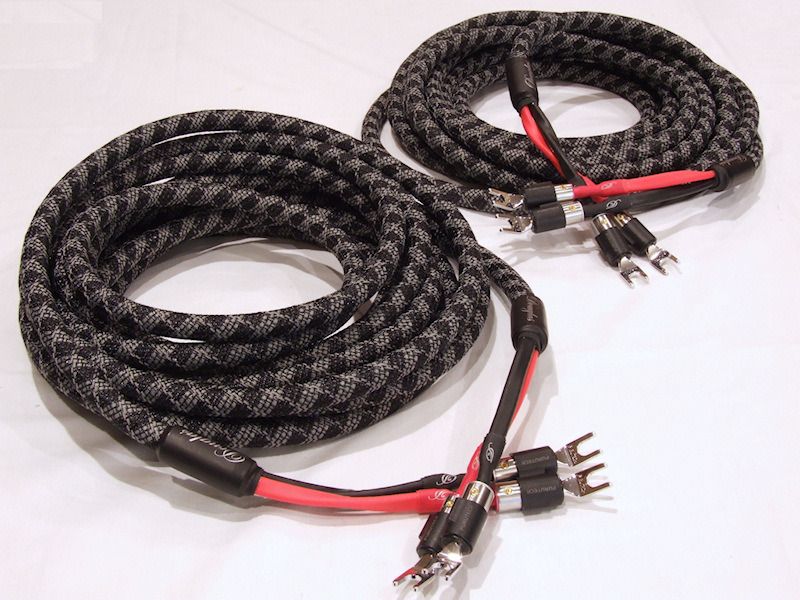
Figure 1. Douglas Connection DCF92 speaker cables, in the attractive "rattlesnake" jacket type that we audiophiles love.
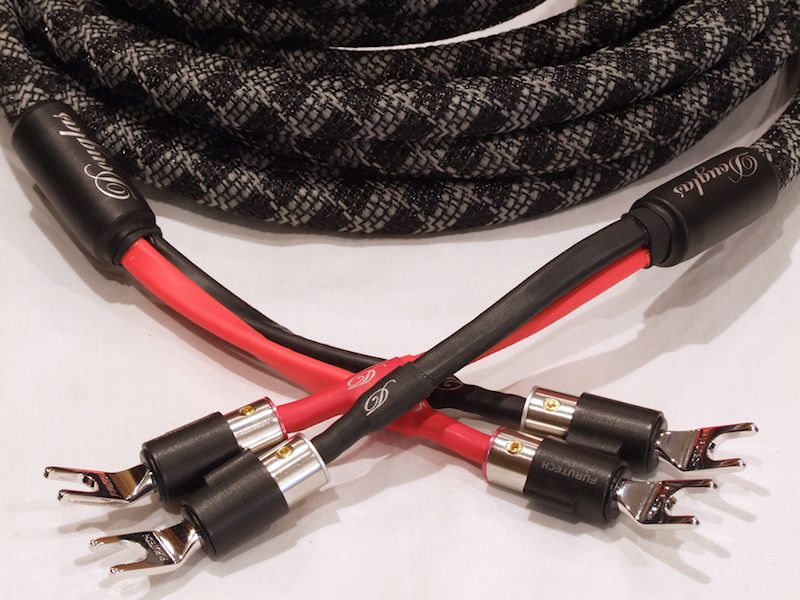
Figure 2. Optional Furutech FT-211 spades.
Starting Point:
Yamaha CDX-1110U CD player
NakamichiCA-5AII preamplifier
Adcom GFA-555 MkII power amplifier
Signal Cable Analog Version 2 RCA interconnects
Signal Cable MagicPower power cords
Monster Cable Z2 Reference speaker cable (25' pair, 12 AWG)
Polk Audio SDA CRS+ loudspeakers (hot-rodded) 4 ohms nominal impedance
Ending Point:
Cary Audio DAC-100 digital to analog converter
Bryston BDP-2 digital player with 500GB internal drive
Adcom GFP-750 preamplifier
Adcom GFA-565SE power amplifier (250 wpc 8 ohms/350 wpc 4 ohms)
Signal Cable Silver Resolution Reference XLR interconnects
Revelation Audio Labs Prophecy Cryo-Silver USB cable
Signal Cable Digital Reference power cords for DAC and digital player
Signal Cable MagicPower cords for power amp and preamp.
PS Audio Dectet Power Conditioner
PS Audio Statement SC power cord for Dectet
Douglas Connection CDF92 speaker cable (9 AWG)
HiFi Tuning Classic Gold fuses for all electronics.
Dell Venue Pro 11 7140 tablet computer for digital player control
Listening Tests
The listening room was 11' x 12' with the loudspeakers in metal bookcases along the 11' wall. The loudspeakers were spaced 6'-10" apart center to center. The listening position was 7' back from the center of the speaker plane.
Listening tests were done in stereo and mono with well recorded and familiar program material. The placement and sonic qualities of sound images within the sound stage were recorded for both sets of cables and compared.
The first trial was a documentation of the sound stage with the Monster Z2R cables.
The second trial was a documentation of the sound stage with Monster Z2R on the left speaker and DCF92 on the right speaker. In mono mode, there was a shift of image weight to the right, along with apparently louder sound and more clarity and detail from the right. In stereo mode, there was more depth at the right. The sound stage curved along the right wall and extended 1' further forward.
The third trial was with DCF92 cables on both speakers. There was more clarity and detail overall and an enhanced sense of space between images in the front to rear direction. The increase in bass detail, articulation, rumble, and growl, was significant.
One of my primary performance goals for this system upgrade was increasing the amount of low volume detail, since this system is in an office setting and I usually can't play at normal (~85 dB-C) listening levels. The DCF92 cables, along with the other cable and equipment upgrades greatly facilitated that goal.
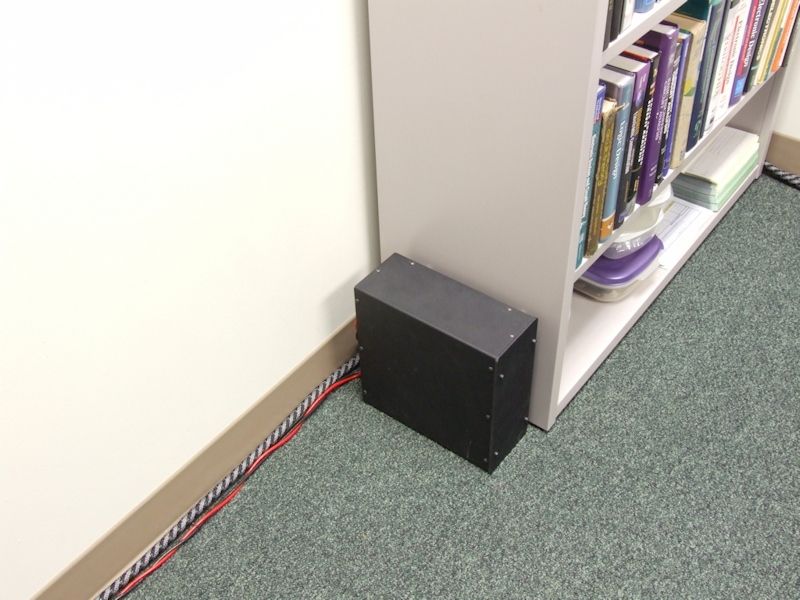
Figure 3. The left speaker's DCF92 cable snakes its way past the SDA CRS+'s 1000VA Dreadnought isolation transformer.

Figure 4. The cable coil makes a nice conversation piece.
Measurements
Measurements of room response, harmonic distortion, and bass decay were taken with the Monster Z2 Reference and Douglas Connection DCF92 cables using Dayton Audio's OmniMic system. The OmniMic's calibrated microphone was placed at the listening position at ear height.
It is easier to see differences in the plots if you save them and flip through them.
The frequency response of the SDA CRS+ loudspeakers is:
25 Hz - 26,000 Hz overall,
42 Hz - 20,000 Hz at 3 dB points.

Figure 5. Room response with Monster Cable Z2 Reference speaker cable.

Figure 6. Room response with Douglas Connection DCF92 speaker cable.
There was a generally smoother frequency response with the DCF92 above 3,000 Hz.
The color coded lines in the harmonic distortion plots represent the following:
Black - frequency response.
Dark blue - sum of 2nd-5th harmonics.
Red - 2nd harmonic.
Purple - 3rd harmonic.
Green - 4th harmonic.
Light blue - 5th harmonic.
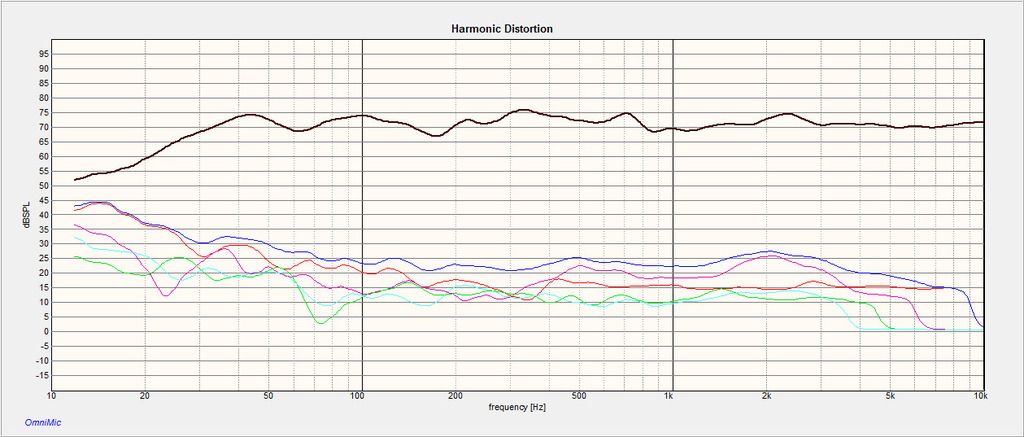
Figure 7. Harmonic distortion measurement with Monster Cable Z2 Reference speaker cable.
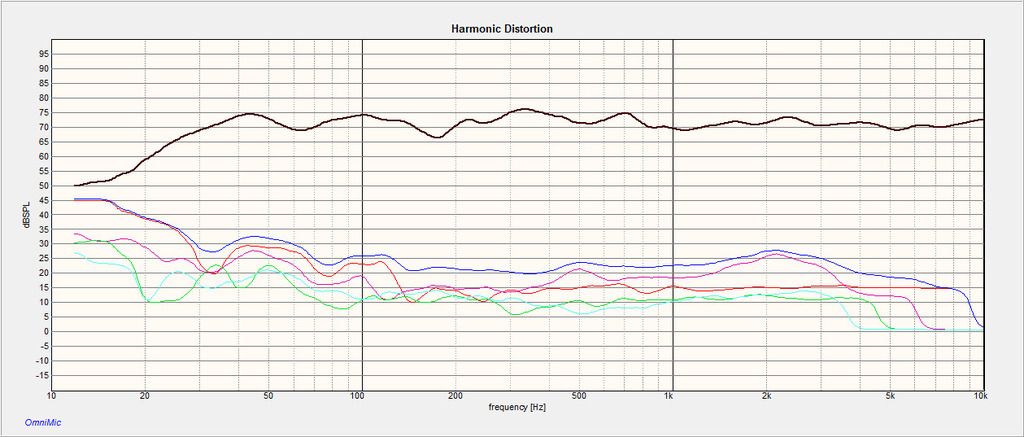
Figure 8. Harmonic distortion measurement with Douglass Connection DCF92 speaker cable.
The DCF92 cables presented an overall lower level of harmonic distortion, particularly 2nd and 3rd order distortion below 200 Hz.
Bass decay plots show how long it takes the sound to decay at each frequency. The ideal situation is flat response which means that some bass notes do not last much longer than others. Significant differences in decay times and very long decay times can cause a decrease in bass definition. Lower and flatter is better.

Figure 9. Bass decay plot with Monster Cable Z2 Reference speaker cable.

Figure 10. Bass decay plot with Douglass Connection DCF92 speaker cable.
Bass response is much tighter and controlled from 40 Hz to 500 Hz with the DCF92. The room excitation below 40 Hz is greater with the DCF92 due to its greater bass energy output.
I started out with just wanting to be freed from the tyranny of little silver discs in my office rig. The 1988 vintage Yamaha CDX-1110U CD player was replaced with a Bryston BDP-2 digital player and a Cary Audio DAC-100 digital to analog converter. My initial intent was to stop there, but the digital source upgrade provided Such Good Sound that I wanted more. I ended up replacing everything...except the loudspeakers. The last things replaced were the speaker cables.

Figure 1. Douglas Connection DCF92 speaker cables, in the attractive "rattlesnake" jacket type that we audiophiles love.

Figure 2. Optional Furutech FT-211 spades.
Starting Point:
Yamaha CDX-1110U CD player
NakamichiCA-5AII preamplifier
Adcom GFA-555 MkII power amplifier
Signal Cable Analog Version 2 RCA interconnects
Signal Cable MagicPower power cords
Monster Cable Z2 Reference speaker cable (25' pair, 12 AWG)
Polk Audio SDA CRS+ loudspeakers (hot-rodded) 4 ohms nominal impedance
Ending Point:
Cary Audio DAC-100 digital to analog converter
Bryston BDP-2 digital player with 500GB internal drive
Adcom GFP-750 preamplifier
Adcom GFA-565SE power amplifier (250 wpc 8 ohms/350 wpc 4 ohms)
Signal Cable Silver Resolution Reference XLR interconnects
Revelation Audio Labs Prophecy Cryo-Silver USB cable
Signal Cable Digital Reference power cords for DAC and digital player
Signal Cable MagicPower cords for power amp and preamp.
PS Audio Dectet Power Conditioner
PS Audio Statement SC power cord for Dectet
Douglas Connection CDF92 speaker cable (9 AWG)
HiFi Tuning Classic Gold fuses for all electronics.
Dell Venue Pro 11 7140 tablet computer for digital player control
Listening Tests
The listening room was 11' x 12' with the loudspeakers in metal bookcases along the 11' wall. The loudspeakers were spaced 6'-10" apart center to center. The listening position was 7' back from the center of the speaker plane.
Listening tests were done in stereo and mono with well recorded and familiar program material. The placement and sonic qualities of sound images within the sound stage were recorded for both sets of cables and compared.
The first trial was a documentation of the sound stage with the Monster Z2R cables.
The second trial was a documentation of the sound stage with Monster Z2R on the left speaker and DCF92 on the right speaker. In mono mode, there was a shift of image weight to the right, along with apparently louder sound and more clarity and detail from the right. In stereo mode, there was more depth at the right. The sound stage curved along the right wall and extended 1' further forward.
The third trial was with DCF92 cables on both speakers. There was more clarity and detail overall and an enhanced sense of space between images in the front to rear direction. The increase in bass detail, articulation, rumble, and growl, was significant.
One of my primary performance goals for this system upgrade was increasing the amount of low volume detail, since this system is in an office setting and I usually can't play at normal (~85 dB-C) listening levels. The DCF92 cables, along with the other cable and equipment upgrades greatly facilitated that goal.

Figure 3. The left speaker's DCF92 cable snakes its way past the SDA CRS+'s 1000VA Dreadnought isolation transformer.

Figure 4. The cable coil makes a nice conversation piece.
Measurements
Measurements of room response, harmonic distortion, and bass decay were taken with the Monster Z2 Reference and Douglas Connection DCF92 cables using Dayton Audio's OmniMic system. The OmniMic's calibrated microphone was placed at the listening position at ear height.
It is easier to see differences in the plots if you save them and flip through them.
The frequency response of the SDA CRS+ loudspeakers is:
25 Hz - 26,000 Hz overall,
42 Hz - 20,000 Hz at 3 dB points.

Figure 5. Room response with Monster Cable Z2 Reference speaker cable.

Figure 6. Room response with Douglas Connection DCF92 speaker cable.
There was a generally smoother frequency response with the DCF92 above 3,000 Hz.
The color coded lines in the harmonic distortion plots represent the following:
Black - frequency response.
Dark blue - sum of 2nd-5th harmonics.
Red - 2nd harmonic.
Purple - 3rd harmonic.
Green - 4th harmonic.
Light blue - 5th harmonic.

Figure 7. Harmonic distortion measurement with Monster Cable Z2 Reference speaker cable.

Figure 8. Harmonic distortion measurement with Douglass Connection DCF92 speaker cable.
The DCF92 cables presented an overall lower level of harmonic distortion, particularly 2nd and 3rd order distortion below 200 Hz.
Bass decay plots show how long it takes the sound to decay at each frequency. The ideal situation is flat response which means that some bass notes do not last much longer than others. Significant differences in decay times and very long decay times can cause a decrease in bass definition. Lower and flatter is better.

Figure 9. Bass decay plot with Monster Cable Z2 Reference speaker cable.

Figure 10. Bass decay plot with Douglass Connection DCF92 speaker cable.
Bass response is much tighter and controlled from 40 Hz to 500 Hz with the DCF92. The room excitation below 40 Hz is greater with the DCF92 due to its greater bass energy output.
Proud and loyal citizen of the Digital Domain and Solid State Country!
Comments
-
I thought I remember F1Nut saying not to coil speaker wire as such, can you comment on that?afterburnt wrote: »They didn't speak a word of English, they were from South Carolina.
Village Idiot of Club Polk -
Indeed, it is his second commandment.I thought I remember F1Nut saying not to coil speaker wire as such, can you comment on that?
-
It got a mention in this thread:
http://forum.polkaudio.com/discussion/comment/1980756#Comment_1980756
"When you coil the wire it tends to act as an inductor and can induce unwanted noise. If you have to coil it do it in a figure eight pattern this will help cancel the noise."
Does this apply to all cables? Power cords, HDMI cables? I currently have a HDMI cable that is a little longer than I need. It's 3m, a 2m cord would have been about six inches too short. I'm curious, since HDMI is digital, would it have no affect? Or effect? I get the two mixed up. -
Is it shielded? I wouldn't coil a HDMI cable. More chance for the signal to degrade
I figure. This is opinion only. -
An inductor consists of a solid core wire or a stranded wire rigidly wound around a ferrometallic, plastic, or air core. Energy is stored in the magnetic field generated by current passing through the wire.
Coiled speaker cables make very poor inductors for the following reasons:
1. A speaker cable consists of two wires which carry current in opposite directions. The magnetic fields generated in each wire are oriented in opposing directions and nearly cancel each other. The cancellation is not perfect due to the complex time-varying and frequency-varying nature of music signals. The signal traveling in the positive and negative conductors are not exact opposites of each other.
In a power cable, there is only the main 60 Hz signal and its harmonics. Therefore the signals on the positive and negative conductors of a power cable are mirror images of each other and you get perfect cancellation. An AC clamp meter measures current by electromagnetic induction, or measuring changes in the magnetic field around a wire. Placing the clamp meter around an AC power cable results in a reading of 0 amps becaue the fields around the positive and negative conductors cancel each other: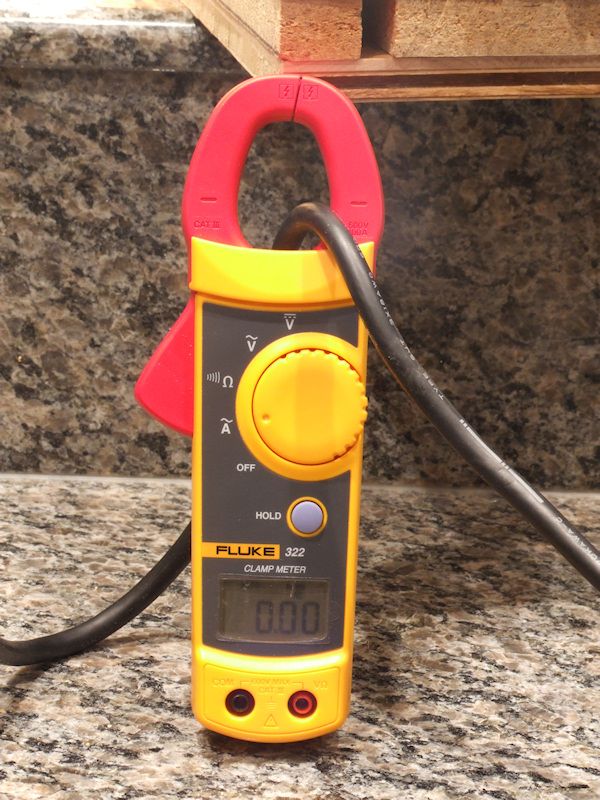
Using an adapter that separates the positive and negative conductors allows current measurments: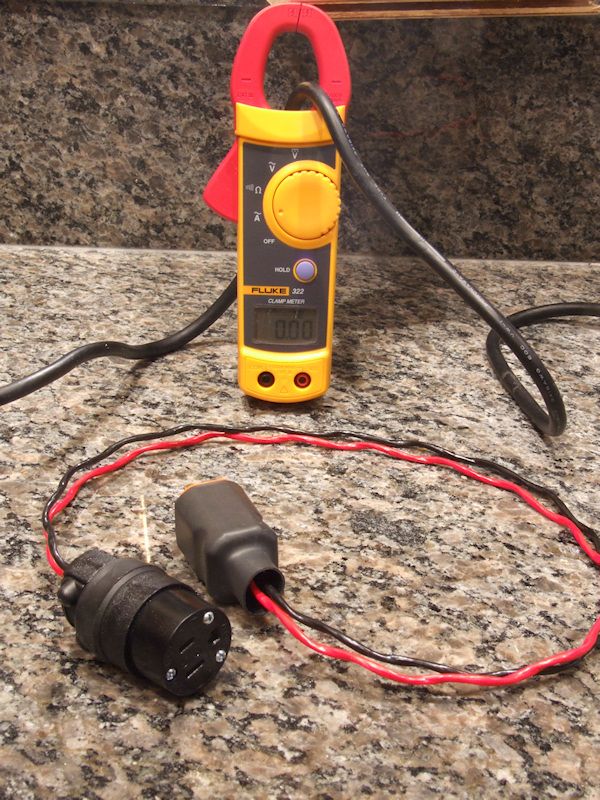
Placing the clamp around either of the adapter's conductors gave a current reading of 0.84 amps: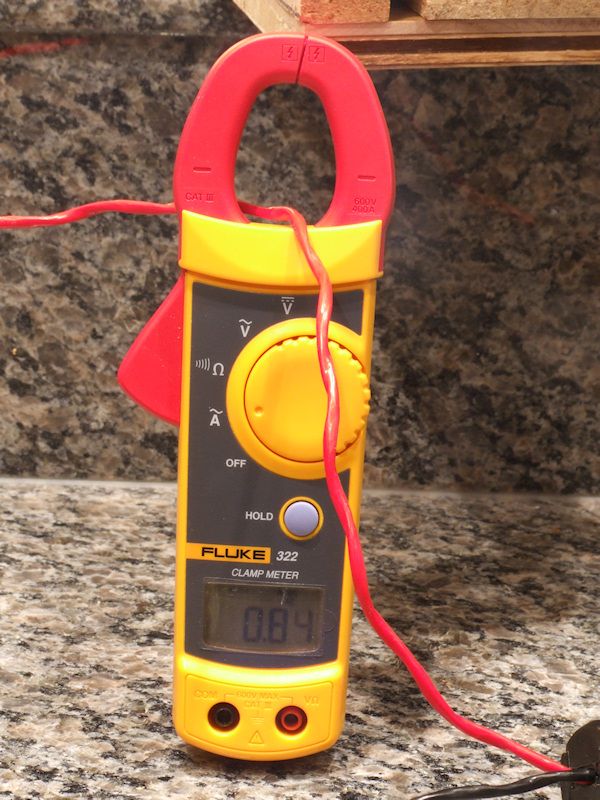
Placing the clamp meter around both of the adapter's conductors resulted in a reading of 0, due to magnetic field cancellation: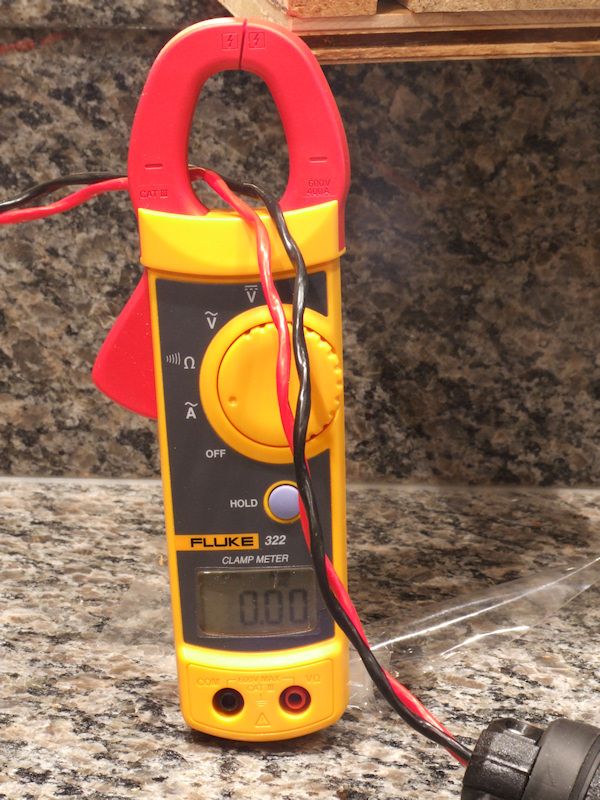
2. Even if speaker wire only had one conductor, the stranded wire used would lower the inductance due to strand interaction.
3. Even if speaker wire had only one conductor, loosely arranging speaker wire in imprecise coils would lower the inductance.
4. Air core inductors have less inductance for a given amount of wired than ferrometallic core inductors. However, air core inductors have higher saturation threshholds.
5. Speaker cables usually employ some type of twist geometry aimed at enhancing the cancellation effect of the opposing electromagnetic fields in the positive and negative conductors.
Here are some measurement results to consider. I measured the inductance of the positive conductor of a 25' Monster Cable Z2 Reference speaker cable loosely arranged in a meandering pattern, a loosely arranged coil pattern, and a tight coil pattern wound around a can of paint. Inductance measurements were taken with an MCP BR2822 LCR meter at a frequency of 120 Hz:
Meandering pattern: 423 micro-Henries.
Loose coil pattern: 162 micro-Henries.
Tight coil pattern around paint can: 146 micro-Henries.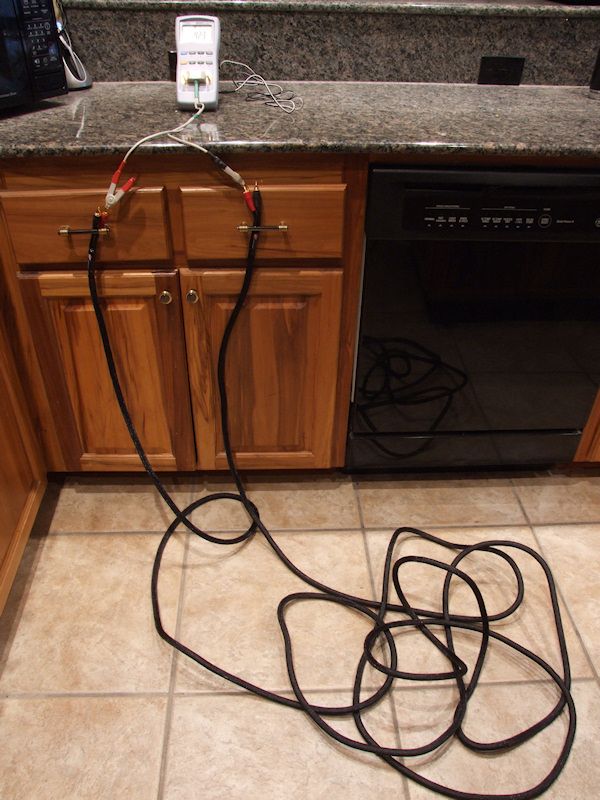
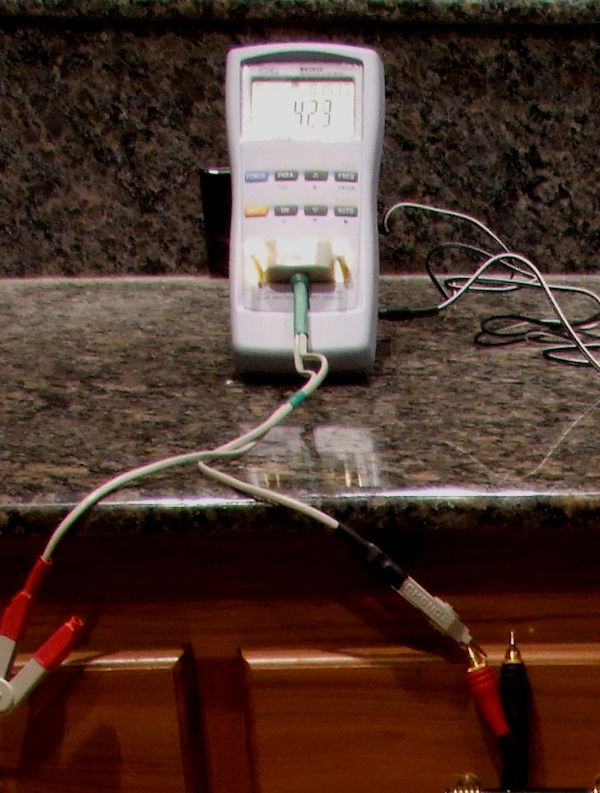

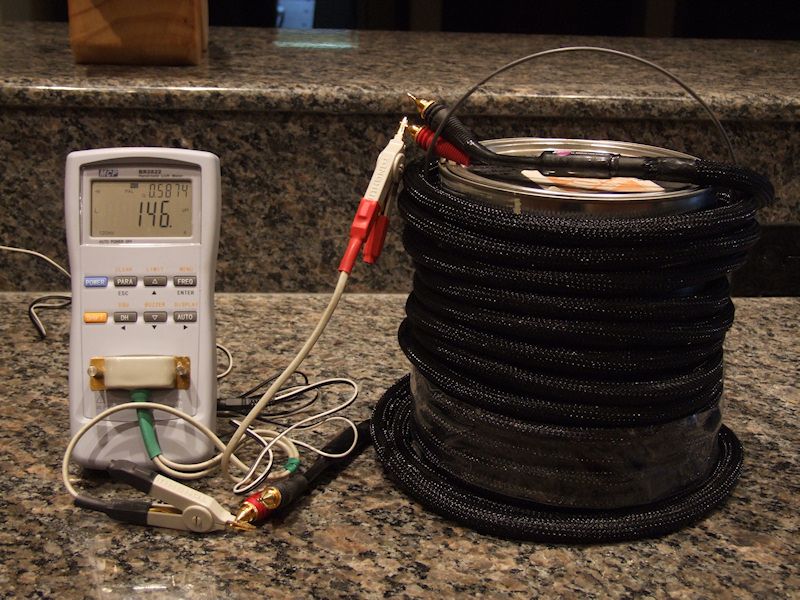
I have never heard a difference between coiled and uncoiled speaker cables. However, if the speaker cables are not well shielded and are bunched in a coil next to electrical noise sources, then coiling the cables, rather than spreading them out, would make them more susceptible to induced noise. This is not a matter of increased inductance. It is a matter of more of the cable being in a noise adverse environment.
Post edited by DarqueKnight onProud and loyal citizen of the Digital Domain and Solid State Country! -
interesting, and thanks for your efforts in this.
curious, for those not familiar with electrical, can you offer some sense of "scale" to the differences we're seeing in those inductance figures?
what might one expect to experience with high and low inductance?
I have absolutely zero experience with this, so what's good? what's bad? what to avoid?I disabled signatures. -
interesting, and thanks for your efforts in this.
curious, for those not familiar with electrical, can you offer some sense of "scale" to the differences we're seeing in those inductance figures?
The measured inductances are in millionths (micro) Henries. For reference, the inductors in speaker crossover networks are in thousandths (milli) Henries, or an order of a thousand times greater.what might one expect to experience with high and low inductance?
I have absolutely zero experience with this, so what's good? what's bad? what to avoid?
You can't assign a "good" or "bad" character to a cable's inductance measurement because
1. Inductance varies with frequency.
2. The inductance of a cable must be considered within the context of how it fits in with a cable's other performance parameters such as capacitance, resistance, and noise performance.
Proud and loyal citizen of the Digital Domain and Solid State Country! -
okay, yeah, for reference was more what I was asking, not "scale"; thank you.
I think I understand what you are saying about good/bad. In the context of "you shouldn't coil cables" are these readings indicating "negligible" impact? or are these readings not relevant because the cables aren't in use and we don't know what they do in various physical configurations with signal passing through?
had a couple of circuits classes years ago, but either forgetting everything I learned, didn't learn anything useful, or just don't know how to apply it to real world. prob a bit of everything I disabled signatures.
I disabled signatures. -
The impact is negligible because:
1. Inductors store energy in the magnetic field generated by current flowing through the conductors.
2. In a two-conductor speaker wire, the currents in each conductor flow in opposite directions, therefore the magnetic fields are in opposite directions and nearly cancel each other out.
To reiterate: I have never heard a difference between coiling, "figure eight", or meandering speaker cable arrangements.
You may hear a difference between coiled and uncoiled speaker cables if the cables are not well shielded and the coil is placed close to an electrical noise source. In that case, simply moving the coil should resolve the issue.Proud and loyal citizen of the Digital Domain and Solid State Country! -
Political Correctness'.........defined
"A doctrine fostered by a delusional, illogical minority and rabidly promoted by an unscrupulous mainstream media, which holds forth the proposition that it is entirely possible to pick up a t-u-r-d by the clean end."
President of Club Polk -
Well Ray, you seem to have debunked an almost universal rule of
audio. Good job!Political Correctness'.........defined
"A doctrine fostered by a delusional, illogical minority and rabidly promoted by an unscrupulous mainstream media, which holds forth the proposition that it is entirely possible to pick up a t-u-r-d by the clean end."
President of Club Polk -
Great read Ray leave it to you to be able walk back to the closet and grab a debunking tool.AWESOME. Doug's stuff is no joke that's for sure.
-
All in good fun!Very good, I enjoyed that.
For example... How many Henries does it take to coil a cable? And the better question... The can of paint that was used to coil the cable around, was it black paint? And if so, where was it purchased?
I'm using RTi8 towers as my fronts and I complained repeatedly how they sounded flat at lower volume levels. I'm a novice when it comes to speaker cables, but when I upgraded to Doug's Furez cables, the difference was amazingly noticeable, for the better. The flat sound was replaced with detail. I went with the bi-wire so I was able to eliminate the stock jumpers. DK, have you ever tried to measure the difference in using different jumpers on the same set of speakers?
-
The can of paint that was used to coil the cable around, was it black paint? And if so, where was it purchased?
That's Ralph Lauren interior matte, brilliant white, RL3191, from Home Depot.DK, have you ever tried to measure the difference in using different jumpers on the same set of speakers?
Yes, and it turned out to be quite a controversial thread, when the usual anti-audiophile suspects showed up:
five-speaker-jumper-comparisons-for-the-sda-srs-1-2tl
Proud and loyal citizen of the Digital Domain and Solid State Country! -
Never thought it matter much with shielded cables. Unshielded is where trouble starts with coiling cables as Ray already pointed out.HT SYSTEM-
Sony 850c 4k
Pioneer elite vhx 21
Sony 4k BRP
SVS SB-2000
Polk Sig. 20's
Polk FX500 surrounds
Cables-
Acoustic zen Satori speaker cables
Acoustic zen Matrix 2 IC's
Wireworld eclipse 7 ic's
Audio metallurgy ga-o digital cable
Kitchen
Sonos zp90
Grant Fidelity tube dac
B&k 1420
lsi 9's -
Thanks for going through all that work. I don't understand much of it, never even heard of the value "micro-Henries", but I understand the bottom line.DarqueKnight wrote: »I have never heard a difference between coiled and uncoiled speaker cables. However, if the speaker cables are not well shielded and are bunched in a coil next to electrical noise sources, then coiling the cables, rather than spreading them out, would make them more susceptible to induced noise. This is not a matter of increased inductance. It is a matter of more of the cable being in a noise adverse environment.
afterburnt wrote: »They didn't speak a word of English, they were from South Carolina.
Village Idiot of Club Polk -
I guess in the right situation you can pick up interference even in shield cable with the right equipment. Cheap T.V.s with shielded RG6 in an high rise apartment were complaining about the local radio station interference (WRUW-FM, more music, fewer hits) Pretty extreme.
-
Thanks for that Ray. I always learn something from your posts."Science is suppose to explain observations not dismiss them as impossible" - Norm on AA; 2.3TL's w/sonicaps/mills/jantzen inductors, Gimpod's boards, Lg Solen SDA inductors, RD-0198's, MW's dynamatted, Armaflex speaker gaskets, H-nuts, brass spikes, Cardas CCGR BP's, upgraded IC Cable, Black Hole Damping Sheet strips, interior of cabinets sealed with Loctite Power Grab, AI-1 interface with 1000VA A-L transformer
-
Awesome information - I really enjoyed this thread - thanks!
I was shocked when I checked Doug's site for the cost on a set of these, incredibly reasonable really considering the quality/results that appear in the review above.
Having just had a great transaction with Doug on some parts to build up a second Dreadnaught Isolation Transformer, he's a great dude to deal with as well. I think I've just added a set of these to the must have list!
Thanks again!VA HT HK AVR20II, Sony S9000ES CD/DVD/SACD, Polk Audio RC80i / Polk Audio CSi3, 60" Panasonic Plasma, Nordost / Signal Cable A2 / Wireworld / Pangea / Magic Power
VA 2 Channel Focal Electra 926 speakers, Pass Labs X150.5 Amp, Eastern Electric MiniMax Preamp (Tutay mods), Eastern Electric Minimax CDP (Scott Nixon mods), Music Hall mmf 5.1 Turntable, Parks Audio Budgie Phono Pre , Audioengine B1 streamer, MIT S3 IC's / MIT Shotgun S3 Speaker Cables / PS Audio power cables
Noggin Schiit Valhalla, Pangea, Phillips Fidelio X1, Polk UF8000
Polk SDA1c modded
Polk CRS+ 4.1TL modded (need veneer)
Polk SDA2BTL (fully modded)
A/L 1000VA Dreadnought Canare 4s11 SDA cable
SACD Marantz DV8300
Sony S9000ES CD/DVD/SACD
Yamaha YP-D6
Soundcraftsmen PCR800
Audible Illusions L1 Preamp
Vincent MFA based Cocci Tube Preamp
Pho-700 Phono Pre
Signal Cable Silver Resolution IC's -
Thank you for the link. I completely forgot about that thread, I actually posted in it. I'll give it a good second read, over the weekend. Have you ever done a comparison on the same exact speaker cable with different terminations? Gold plated bananas vs. unplated copper vs. silver plated copper, etc.?DarqueKnight wrote: »
-
Thank you for the link. I completely forgot about that thread, I actually posted in it. I'll give it a good second read, over the weekend. Have you ever done a comparison on the same exact speaker cable with different terminations? Gold plated bananas vs. unplated copper vs. silver plated copper, etc.?DarqueKnight wrote: »
Not Ray here, but about 8 or 9 months ago I replaced high quality brass nanners with silver plated telurium copper nanners. I did it mostly because I had the latter lying around, not really sure if it would provide much or any improvement.
I was stunned at the increase in clarity. Douglas connections sells the ones I have - it's a really inexpensive upgrade.
"Science is suppose to explain observations not dismiss them as impossible" - Norm on AA; 2.3TL's w/sonicaps/mills/jantzen inductors, Gimpod's boards, Lg Solen SDA inductors, RD-0198's, MW's dynamatted, Armaflex speaker gaskets, H-nuts, brass spikes, Cardas CCGR BP's, upgraded IC Cable, Black Hole Damping Sheet strips, interior of cabinets sealed with Loctite Power Grab, AI-1 interface with 1000VA A-L transformer -
When Doug made my cables, we ended up going with Furez TST non-plated copper nanners. Last year I installed an IEC inlet and while doing research and asking questions, I learned how different metals can effect the sound. I had to make a choice on either a gold or rhodium plated inlet. Each has it's positive and negative attributes; conductivity vs. durability, bright/neutral vs. warm sounding, etc. But since I've never had two different type jumpers, or two inlets with different metals installed on the same unit to compare, or two identical speaker cables with different terminations, I was curious as to how noticeable the difference could be from such a "small link in the chain" and if it was actually measurable. I had used some Belkin cables before Doug's and they had a warmer sound compared to the clear coats I was using before them. I'm not sure if that was due to the wire used, or the fact that the Belkin's used gold plated banana plugs. It's an area I have no experience in. I've only had four cables hooked up to the system I have now. 1990's clear coats with bare wire on the ends, Monster clear coats with bare wire (heard no difference between the two clear coats), Belkin PureAV cables (warmer sound compared to clear coats, a little more detail), and now Doug's Furez 12/4 bi-wire with the non-plated copper terminations (much more detail). I'm curious to whether the big difference I heard with Doug's cables can be contributed to the wire used, the construction, the elimination of the jumpers, the copper banana plugs, or (as I would imagine) a little of all four.drumminman wrote: »Not Ray here, but about 8 or 9 months ago I replaced high quality brass nanners with silver plated telurium copper nanners. I did it mostly because I had the latter lying around, not really sure if it would provide much or any improvement.
I was stunned at the increase in clarity. Douglas connections sells the ones I have - it's a really inexpensive upgrade.
My apologies to DK for changing the topic slightly. -
Have you ever done a comparison on the same exact speaker cable with different terminations? Gold plated bananas vs. unplated copper vs. silver plated copper, etc.?
No.
I have done a comparison of stock, Vampire, Cardas HCBP, and Cardas CCGR binding posts on the same speaker and didn't hear a difference.
Proud and loyal citizen of the Digital Domain and Solid State Country! -
DK, This is good stuff!! Thanks for debunking the coiled speaker cable thing. I have been telling guys, if they have extra cable, to be sure to lay cable back and forth, not coil it.Sunfire Theater Grand IV
Sunfire Cinema Grand Signature
SRS 2.1TL
SDA 2BTL's
CSiA6
FXiA4
FXiA6
SDA 2A's
Monitor 10A's
http://www.douglasconnection.com -
I think you would have better chance of crosstalk at the ends rather than
mid-span. Good connectors, no problems. I bow to others experience in
the matter.
-
9 ga versus 12 ga - should NOT surprise anyone, not to mention the reactive 4 ohm load.DarqueKnight wrote: »Bass response is much tighter and controlled...
...lower resistance! Another no brainier, guys.DarqueKnight wrote: »The room excitation below 40 Hz is greater with the DCF92 due to its...
Since I joined this I've been hawking similar stuff:
10' 10 ga versus 5' 7 ga connecting 4 ohm sub - significant output difference!
I'll take the rest of DK's finding to the bank.Samsung 60" QN65Q7FAMFXZA QLED, Outlaw Audio 976 Pre/Pro, Samsung BDP, Amazon Firestick, Phillips CD Changer
Canare 14 ga - LCR tweeters inside*; Ctr Ch outside
BJC 10 ga - LCR mids “Foamed” & “Plugged**”, inside* & out
8 ga Powerline: LR woofers, inside* & out
*soldered **Rob the Man (Xschop)
LR: Tri-amped RTi A7 w/Rotels*. Woofers - 980BX; Tweets & Mids - RB981*
Ctr Ch: Rotel RB981* -> Bi-amped CSi A6
Surrounds: Rotel 981* -> AR 12 ga -> RTi A3
*all connected w/Premiere ICs
5 Subs: Sunfire True SW Signature -> LFE & Ctr Ch; 4 Audio Pro Evidence @ the “Corners”
Power Conditioning & Distribution:
4 dedicated 20A feeds; APC H15; 5 Furman Miniport 20s -
How about you quote the entire sentence, not just the part that suits you. Here it is, "Bass response is much tighter and controlled from 40 Hz to 500 Hz with the DCF92." I fail to see any mention of gauge.
Again, you failed to quote the entire sentence. Here it is, "The room excitation below 40 Hz is greater with the DCF92 due to its greater bass energy output." No mention of lower resistance.Since I joined this I've been hawking similar stuff:
Indeed, you have been in the dark ages for the entire time.Political Correctness'.........defined
"A doctrine fostered by a delusional, illogical minority and rabidly promoted by an unscrupulous mainstream media, which holds forth the proposition that it is entirely possible to pick up a t-u-r-d by the clean end."
President of Club Polk -
Wish I can say I've had the same experiences others have had with Doug's cables. He's a stellar gentleman, but his cables didn't seem to mesh well for me. I even borrowed some Alpha's from Ernie, already burned in.....eh, not my cup of tea. To each his own though.
The only problem I have with this review is we are comparing to Monster cables. Which in my opinion, isn't too hard to beat. There is a plethora of cable manufacturers out there to get your ears on. Don't just settle for a couple brands, you wouldn't do that in any of your other gear searches I would think.HT SYSTEM-
Sony 850c 4k
Pioneer elite vhx 21
Sony 4k BRP
SVS SB-2000
Polk Sig. 20's
Polk FX500 surrounds
Cables-
Acoustic zen Satori speaker cables
Acoustic zen Matrix 2 IC's
Wireworld eclipse 7 ic's
Audio metallurgy ga-o digital cable
Kitchen
Sonos zp90
Grant Fidelity tube dac
B&k 1420
lsi 9's







